A Novel Red-Emitting Na2NbOF5:Mn4+ Phosphor with Ultrahigh Color Purity for Warm White Lighting and Wide-Gamut Backlight Displays
Abstract
:1. Introduction
2. Experimental Section
2.1. Sample Preparation
2.2. Characterization
3. Results and Discussion
3.1. X-ray Diffraction and Structure Analysis
3.2. Morphology and Composition Identification
3.3. Photoluminescence Properties
3.4. Decay Curves, Chromaticity Coordinates (CIE) and Color Purity
3.5. Electroluminescence (EL) Performance of the Packaged WLEDs
4. Conclusions
Author Contributions
Funding
Institutional Review Board Statement
Informed Consent Statement
Data Availability Statement
Conflicts of Interest
References
- Nair, G.B.; Swart, H.C.; Dhoble, S.J. A review on the advancements in phosphor-converted light emitting diodes (pc-LEDs): Phosphor synthesis device fabrication and characterization. Prog. Mater. Sci. 2020, 109, 100622. [Google Scholar] [CrossRef]
- Cho, J.; Park, J.H.; Kim, J.K.; Schubert, E.F. White light-emitting diodes: History, progress, and future. Laser Photonics Rev. 2017, 11, 1600147. [Google Scholar] [CrossRef]
- Xia, Z.; Xu, Z.; Chen, M.; Liu, Q. Recent developments in the new inorganic solid-state LED phosphors. Dalton Trans. 2016, 45, 11214–11232. [Google Scholar] [CrossRef]
- Chen, D.; Zhou, Y.; Zhong, J. A review on Mn4+ activators in solids for warm white light-emitting diodes. RSC Adv. 2016, 6, 86285–86296. [Google Scholar] [CrossRef]
- Wang, S.; Xu, Y.; Chen, T.; Jiang, W.; Liu, J.; Zhang, X.; Jiang, W.; Wang, L. A red phosphor LaSc3(BO3)4:Eu3+ with zero-thermal-quenching and high quantum efficiency for LEDs. Chem. Eng. J. 2021, 404, 125912. [Google Scholar] [CrossRef]
- Xia, Z.; Meijerink, A. Ce3+-Doped garnet phosphors: Composition modification, luminescence properties and applications. Chem. Soc. Rev. 2017, 46, 275–299. [Google Scholar] [CrossRef] [Green Version]
- Wang, L.; Xie, R.J.; Suehiro, T.; Takeda, T.; Hirosaki, N. Down-conversion nitride materials for solid state lighting: Recent advances and perspectives. Chem. Rev. 2018, 118, 1951–2009. [Google Scholar] [CrossRef]
- Lin, H.; Hu, T.; Huang, Q.; Cheng, Y.; Wang, B.; Xu, J.; Wang, J.; Wang, Y. Non-rare-earth K2XF7:Mn4+ (X = Ta, Nb): A highly-efficient narrow-band red phosphor enabling the application in wide-color-gamut LCD. Laser Photonics Rev. 2017, 11, 1700148. [Google Scholar] [CrossRef]
- Wang, L.; Wang, X.; Kohsei, T.; Yoshimura, K.; Izumi, M.; Hirosaki, N.; Xie, R. Highly efficient narrow-band green and red phosphors enabling wider color-gamut LED backlight for more brilliant displays. Opt. Express 2015, 23, 28707–28717. [Google Scholar] [CrossRef] [PubMed]
- Murphy, J.E.; Garcia-Santamaria, F.; Setlur, A.A.; Sista, S. 62.4: PFS, K2SiF6:Mn4+: The Red-line Emitting LED Phosphor behind GE’s TriGain Technology™ Platform. SID Symp. Dig. Tech. Pap. 2015, 46, 927–930. [Google Scholar] [CrossRef]
- Yu, X.; Wang, Y. Synthesis and photoluminescence improvement of monodispersed Zn2SiO4:Mn2+ nanophosphors. J. Alloys Compd. 2010, 497, 290–294. [Google Scholar] [CrossRef]
- Yadav, R.S.; Pandey, S.K.; Pandey, A.C. BaAl12O19:Mn2+ green emitting nanophosphor for PDP application synthesized by solution combustion method and its Vacuum Ultra-Violet Photoluminescence Characteristics. J. Lumin. 2011, 131, 1998–2003. [Google Scholar] [CrossRef]
- Liang, Z.; Yang, Z.; Tang, H.; Guo, J.; Yang, Z.; Zhou, Q.; Tang, S.; Wang, Z. Synthesis, luminescence properties of a novel oxyfluoride red phosphor BaTiOF4:Mn4+ for LED backlighting. Opt. Mater. 2019, 90, 89–94. [Google Scholar] [CrossRef]
- Fang, M.H.; Wu, W.L.; Jin, Y.; Lesniewski, T.; Mahlik, S.; Grinberg, M.; Brik, M.G.; Srivastava, A.M.; Chiang, C.Y.; Zhou, W.; et al. Control of luminescence by tuning of crystal symmetry and local structure in Mn4+-activated narrow band fluoride phosphors. Angew. Chem. Int. Ed. 2018, 57, 1797–1801. [Google Scholar] [CrossRef] [PubMed] [Green Version]
- Song, E.; Zhou, Y.; Yang, X.B.; Liao, Z.; Zhao, W.; Deng, T.; Wang, L.; Ma, Y.; Ye, S.; Zhang, Q. Highly efficient and stable narrow-band red phosphor Cs2SiF6:Mn4+ for high-power warm white LED applications. ACS Photonics 2017, 4, 2556–2565. [Google Scholar] [CrossRef]
- Lv, L.; Chen, Z.; Liu, G.; Huang, S.; Pan, Y. Optimized photoluminescence of red phosphor K2TiF6:Mn4+ synthesized at room temperature and its formation mechanism. J. Mater. Chem. C 2015, 3, 1935–1941. [Google Scholar] [CrossRef]
- Adachi, S. Photoluminescence properties of Mn4+-activated oxide phosphors for use in white-LED applications: A review. J. Lumin. 2018, 202, 263–281. [Google Scholar] [CrossRef]
- Lü, W.; Lv, W.; Zhao, Q.; Jiao, M.; Shao, B.; You, H. A novel efficient Mn4+ activated Ca14Al10Zn6O35 phosphor: Application in red-emitting and white LEDs. Inorg. Chem. 2014, 53, 11985–11990. [Google Scholar] [CrossRef]
- Wang, B.; Lin, H.; Huang, F.; Xu, J.; Chen, H.; Lin, Z.; Wang, Y. Non-Rare-Earth BaMgAl10–2xO17:xMn4+, xMg2+: A Narrow-Band Red Phosphor for Use as a High-Power Warm w-LED. Chem. Mater. 2016, 28, 3515–3524. [Google Scholar] [CrossRef]
- Zhou, Z.; Zheng, J.; Shi, R.; Zhang, N.; Chen, J.; Zhang, R.; Suo, H.; Goldys, E.M.; Guo, C. Ab initio site occupancy and far-red emission of Mn4+ in cubic-phase La(MgTi)1/2O3 for plant cultivation. ACS Appl. Mater. Int. 2017, 9, 6177–6185. [Google Scholar] [CrossRef]
- Kong, L.; Liu, Y.; Dong, L.; Zhang, L.; Qiao, L.; Wang, W.; You, H. Enhanced red luminescence in CaAl12O19:Mn4+ via doping Ga3+ for plant growth lighting. Dalton Trans. 2020, 49, 1947–1954. [Google Scholar] [CrossRef] [PubMed]
- Cao, R.; Liu, X.; Bai, K.; Chen, T.; Guo, S.; Hu, Z.; Xiao, F.; Luo, Z. Photoluminescence properties of red-emitting Li2ZnSn2O6:Mn4+ phosphor for solid-state lighting. J. Lumin. 2018, 197, 169–174. [Google Scholar] [CrossRef]
- Nguyen, H.D.; Lin, C.C.; Fang, M.H.; Liu, R.S. Synthesis of Na2SiF6:Mn4+ red phosphors for white LED applications by co-precipitation. J. Mater. Chem. C 2014, 2, 10268–10272. [Google Scholar] [CrossRef]
- Wang, Z.; Liu, Y.; Zhou, Y.; Zhou, Q.; Tan, H.; Zhang, Q.; Peng, J. Red-emitting phosphors Na2XF6:Mn4+ (X = Si, Ge, Ti) with high colour-purity for warm white-light-emitting diodes. RSC Adv. 2015, 5, 58136–58140. [Google Scholar] [CrossRef]
- Wei, L.L.; Lin, C.C.; Fang, M.H.; Brik, M.G.; Hu, S.F.; Jiao, H.; Liu, R.S. A low-temperature co-precipitation approach to synthesize fluoride phosphors K2MF6:Mn4+ (M = Ge, Si) for white LED applications. J. Mater. Chem. C 2015, 3, 1655–1660. [Google Scholar] [CrossRef]
- Zhu, H.; Lin, C.C.; Luo, W.; Shu, S.; Liu, Z.; Liu, Y.; Kong, J.; Ma, E.; Cao, Y.; Liu, R.S.; et al. Highly efficient non-rare-earth red emitting phosphor for warm white light-emitting diodes. Nat. Commun. 2014, 5, 4312. [Google Scholar] [CrossRef] [Green Version]
- Zhou, Y.; Zhang, S.; Wang, X.; Jiao, H. Structure and luminescence properties of Mn4+-activated K3TaO2F4 red phosphor for white LEDs. Inorg. Chem. 2019, 58, 4412–4419. [Google Scholar] [CrossRef] [PubMed]
- Hu, M.; Liu, Z.; Xia, Y.; Zhang, G.; Fang, Y.; Liu, Y.; Zhao, G.; Hou, J. The photoluminescence adjustment of red phosphors ANaWO2F4:Mn4+ (A = Li, Na, K) by suitable tolerance factor designing. J. Mater. Sci. Mater. Electron. 2020, 31, 4535–4541. [Google Scholar] [CrossRef]
- Hu, T.; Lin, H.; Cheng, Y.; Huang, Q.; Xu, J.; Gao, Y.; Wang, J.; Wang, Y. A highly-distorted octahedron with a C2v group symmetry inducing an ultra-intense zero phonon line in Mn4+-activated oxyfluoride Na2WO2F4. J. Mater. Chem. C 2017, 5, 10524–10532. [Google Scholar] [CrossRef]
- Ming, H.; Zhang, J.; Liu, L.; Peng, J.; Du, F.; Ye, X.; Yang, Y.; Nie, H. A novel Cs2NbOF5:Mn4+ oxyfluoride red phosphor for light-emitting diode devices. Dalton. Trans. 2018, 47, 16048–16056. [Google Scholar] [CrossRef]
- Wang, Z.; Yang, Z.; Yang, Z.; Wei, Q.; Zhou, Q.; Ma, L.; Wang, X. Red phosphor Rb2NbOF5: Mn4+ for warm white light-emitting diodes with a high color-rendering index. Inorg. Chem. 2018, 58, 456–461. [Google Scholar] [CrossRef] [PubMed]
- Verstraete, R.; Sijbom, H.F.; Joos, J.J.; Korthout, K.; Poelman, D.; Detavernier, C.; Smet, P.F. Red Mn4+-doped fluoride phosphors: Why purity matters. ACS Appl. Mater. Int. 2018, 10, 18845–18856. [Google Scholar] [CrossRef] [PubMed]
- Marvel, M.R.; Pinlac, R.A.F.; Lesage, J.; Stern, C.L.; Poeppelmeier, K.R. Chemical hardness and the adaptive coordination behavior of the d0 transition metal oxide fluoride anions. Z. Anorg. Allg. Chem. 2009, 635, 869–877. [Google Scholar] [CrossRef]
- Park, K.; Hakeem, D.A. Improved photoluminescence properties of BaAl2Si2O8:Eu3+, Tb3+ phosphors by doping Tb3+. Ceram. Int. 2017, 43, 4725–4729. [Google Scholar] [CrossRef]
- Jin, Y.; Fang, M.H.; Grinberg, M.; Mahlik, S.; Lesniewski, T.; Brik, M.G.; Luo, G.Y.; Lin, J.G.; Liu, R.S. Narrow red emission band fluoride phosphor KNaSiF6:Mn4+ for warm white light-emitting diodes. ACS Appl. Mater. Int. 2016, 8, 11194–11203. [Google Scholar] [CrossRef] [PubMed]
- Senden, T.; van Dijk-Moes, R.; Meijerink, A. Quenching of the red Mn4+ luminescence in Mn4+-doped fluoride LED phosphors. Light Sci. Appl. 2018, 7, 8. [Google Scholar] [CrossRef]
- Cao, Y.; Zhang, G.; Fang, Y.; Yin, X.; Lin, Y.; Zhao, G.; Liu, Y.; Sun, H.; Huang, F.; Hou, J. Tuning Coordination Environments of Dopants through Topochemical Reaction Enables Substantial Enhancement of Luminescence in Mn4+-Doped Perovskite. J. Phys. Chem. C 2021, 125, 4646–4654. [Google Scholar] [CrossRef]
- Huang, D.; Zhu, H.; Deng, Z.; Zou, Q.; Lu, H.; Yi, X.; Guo, W.; Lu, C.; Chen, X. Moisture-Resistant Mn4+-Doped Core–Shell-Structured Fluoride Red Phosphor Exhibiting High Luminous Efficacy for Warm White Light-Emitting Diodes. Angew. Chem. Int. Ed. 2019, 58, 3843–3847. [Google Scholar] [CrossRef]
- Donegan, J.F.; Glynn, T.J.; Imbusch, G.F.; Remeika, J.P. Luminescence and fluorescence line narrowing studies of Y3Al5O12:Mn4+. J. Lumin. 1986, 36, 93–100. [Google Scholar] [CrossRef]
- Zhou, Q.; Liang, Z.; Shi, D.; Wang, Z.; Wang, K.; Tang, H.; Milićević, B.; Wu, M. Double sites occupancy of Mn4+ in Cs2NaAlF6 with enhanced photoluminescence for white light-emitting diodes. J. Alloys Compd. 2020, 832, 154884. [Google Scholar] [CrossRef]
- Zhang, X.; Tsai, Y.T.; Wu, S.M.; Lin, Y.C.; Lee, J.F.; Sheu, H.S.; Cheng, B.M.; Liu, R.S. Facile atmospheric pressure synthesis of high thermal stability and narrow-band red-emitting SrLiAl3N4:Eu2+ phosphor for high color rendering index white light-emitting diodes. ACS Appl. Mater. Int. 2016, 8, 19612–19617. [Google Scholar] [CrossRef] [PubMed]
- Zhu, Y.; Cao, L.; Brik, M.G.; Zhang, X.; Huang, L.; Xuan, T.; Wang, J. Facile synthesis, morphology and photoluminescence of a novel red fluoride nanophosphor K2NaAlF6:Mn4+. J. Mater. Chem. C 2017, 5, 6420–6426. [Google Scholar] [CrossRef]
- Zhu, Y.; Liu, Y.; Brik, M.G.; Huang, L.; Xuan, T.; Wang, J. Controlled morphology and improved photoluminescence of red emitting K2LiAlF6:Mn4+ nano-phosphor by co-doping with alkali metal ions. Opt. Mater. 2017, 74, 52–57. [Google Scholar] [CrossRef]

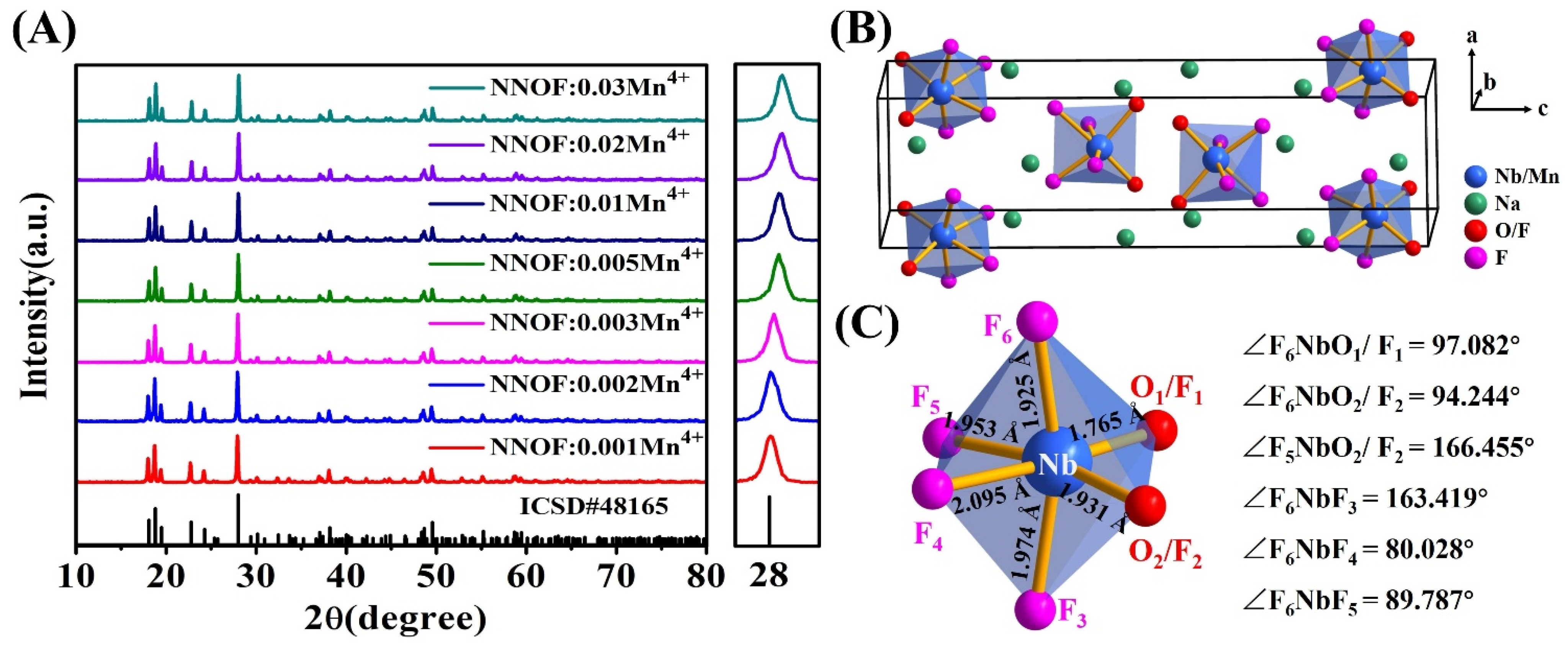
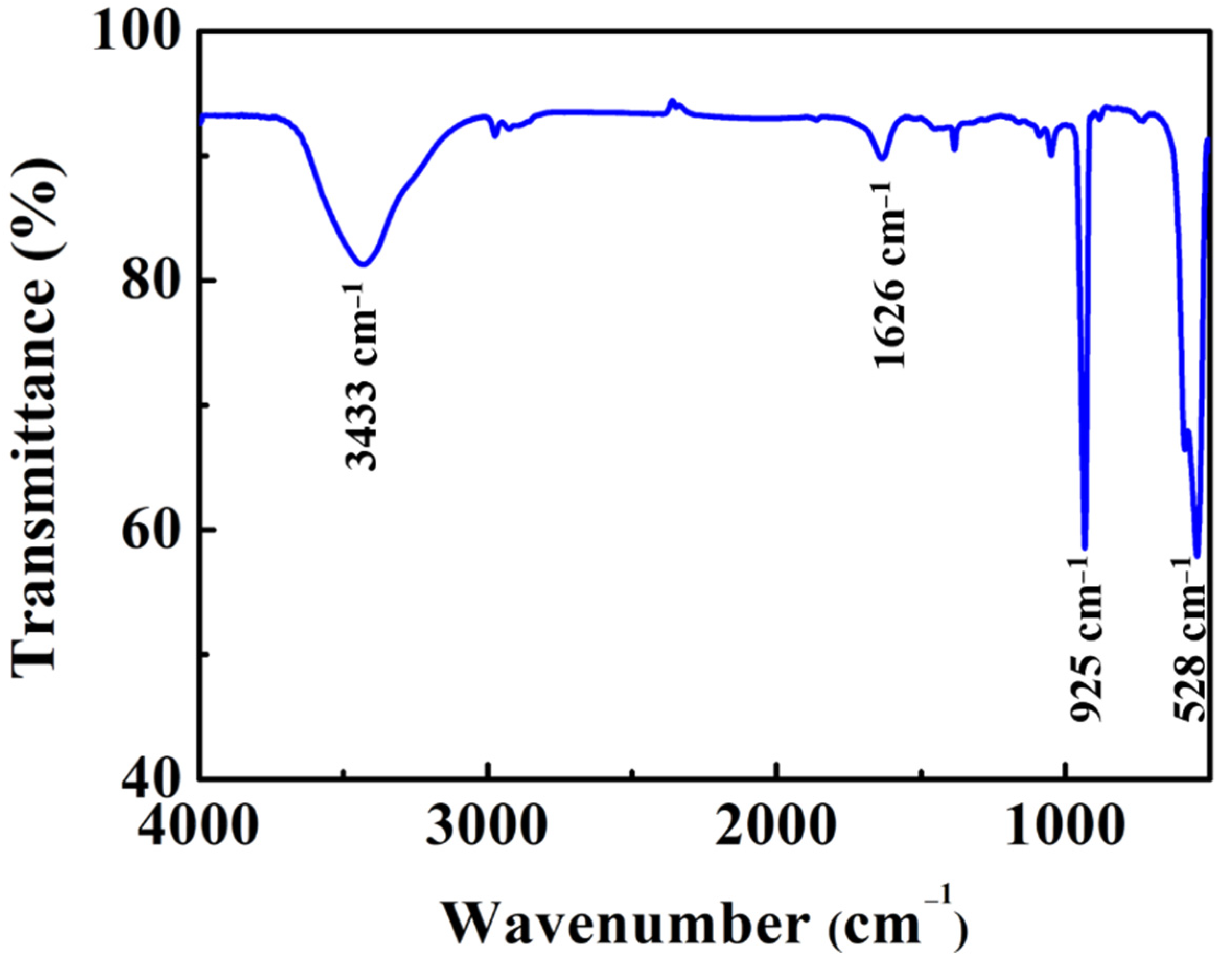
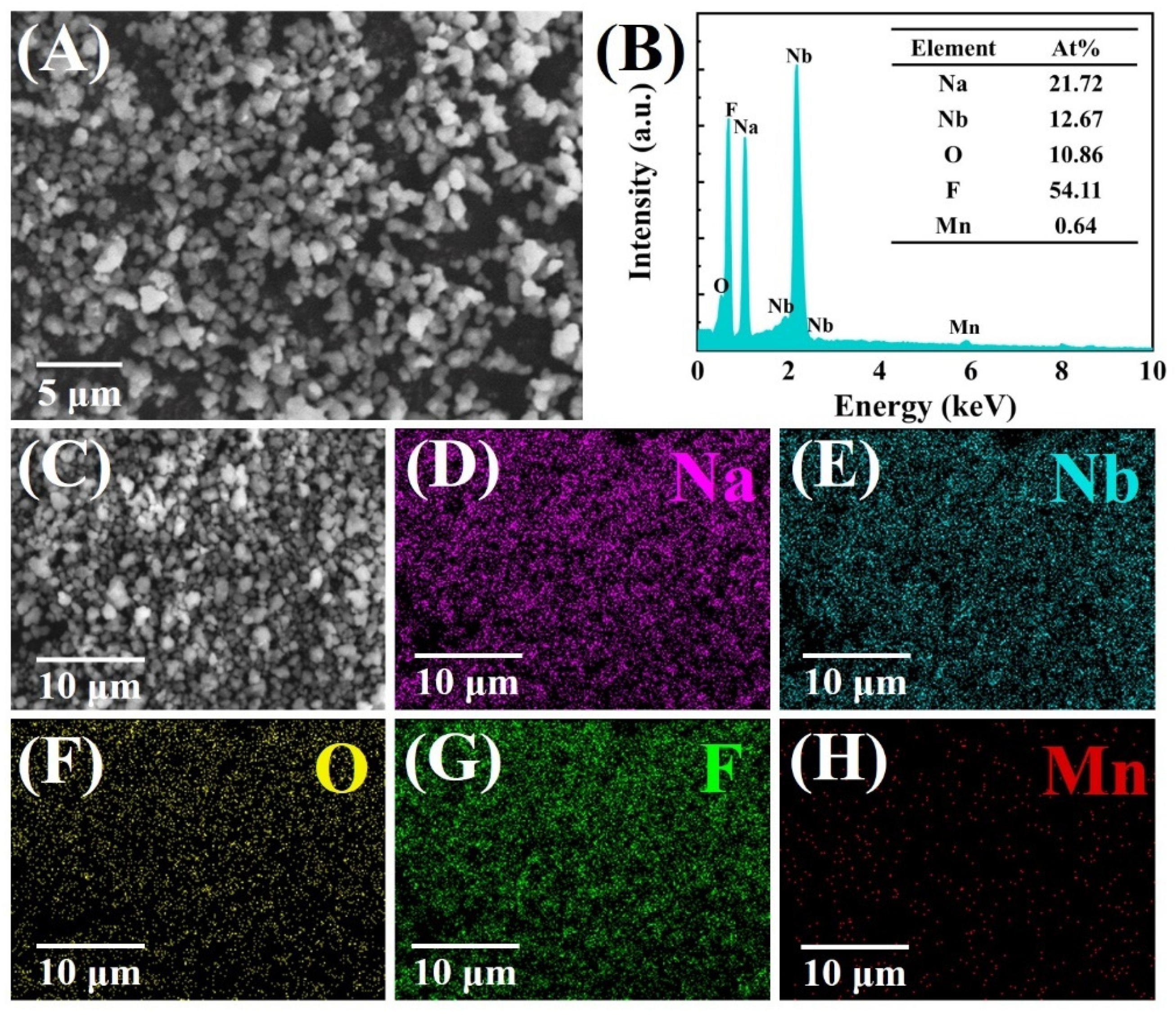
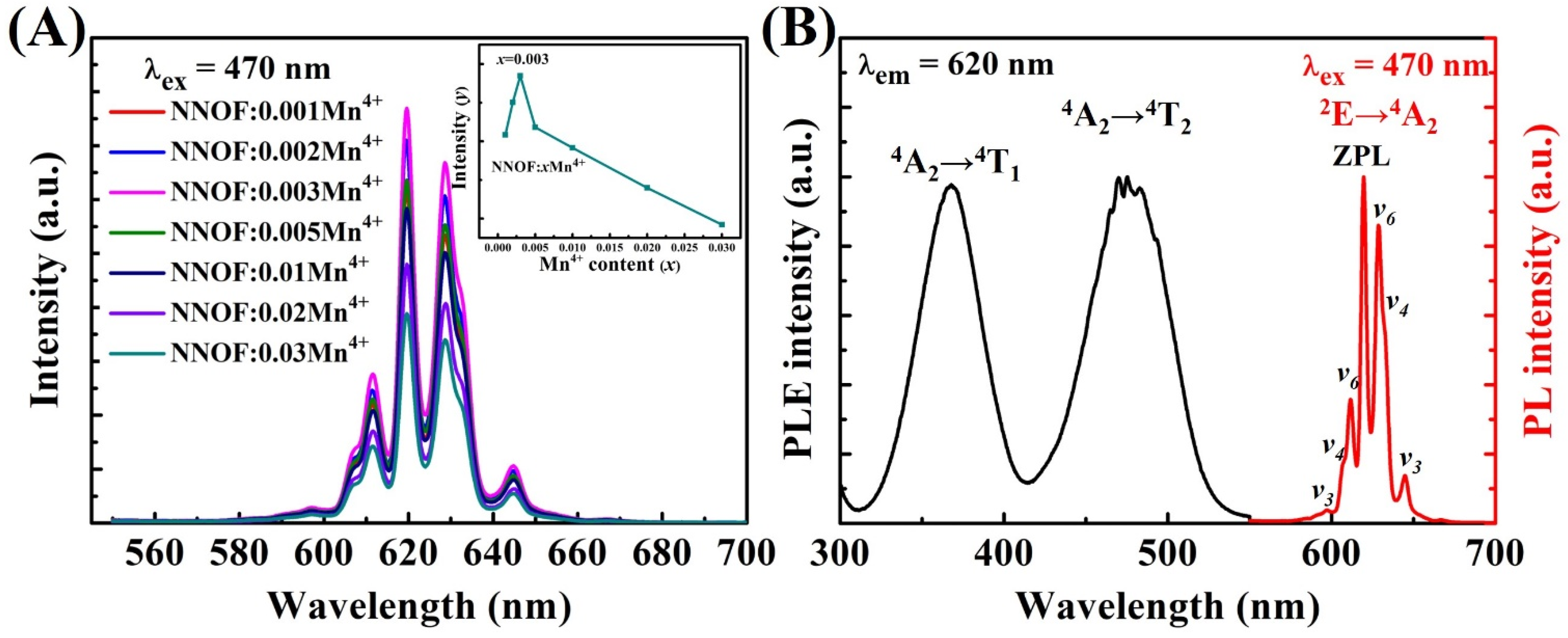
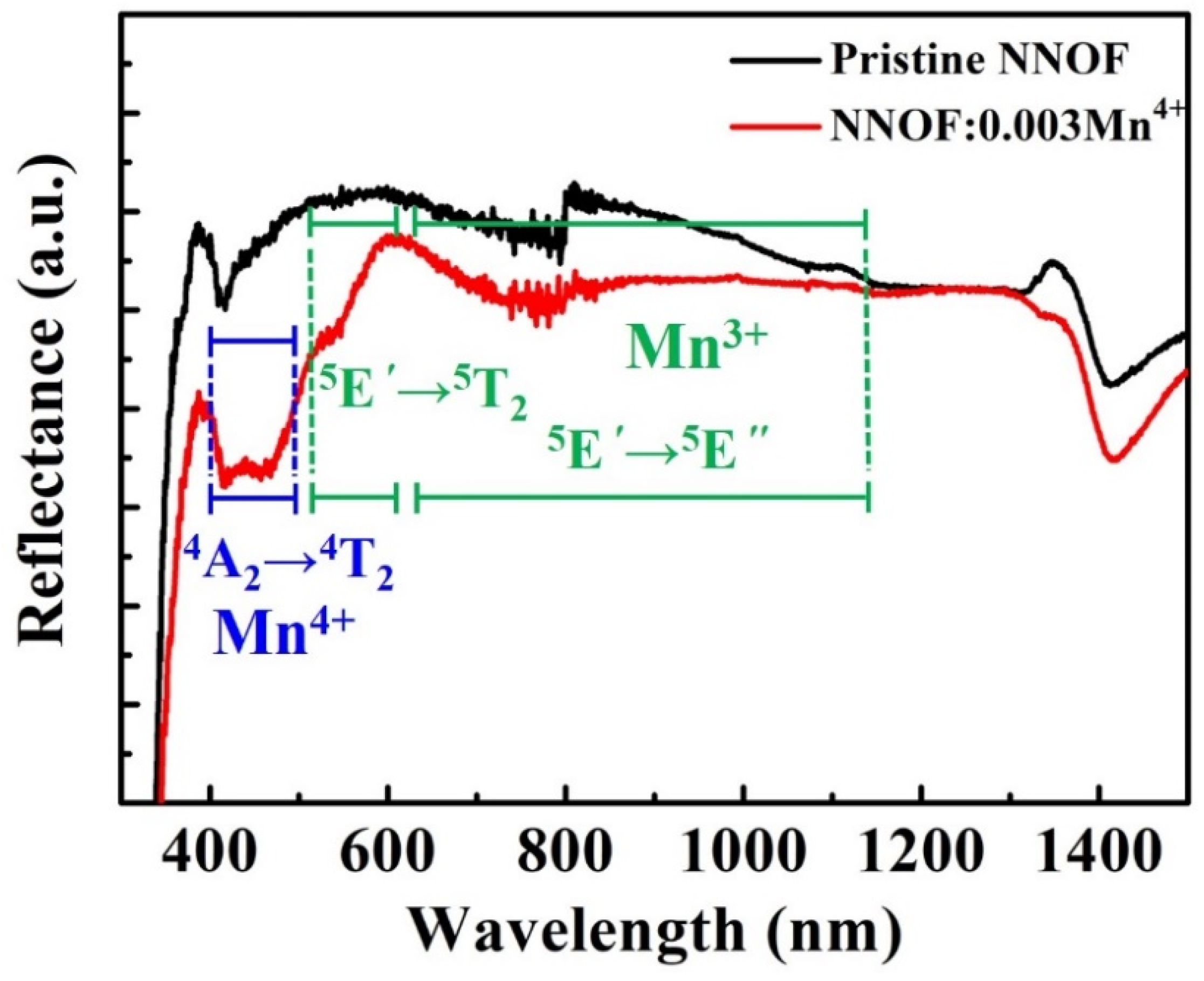
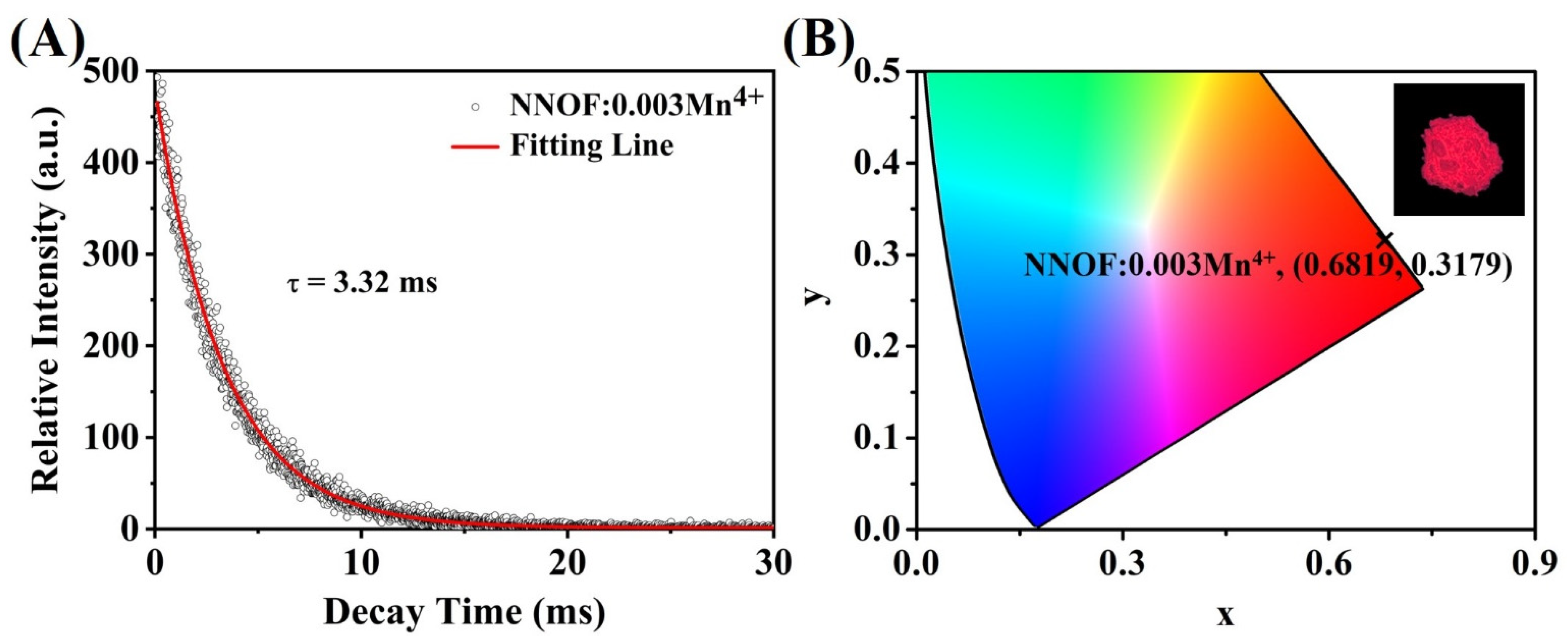
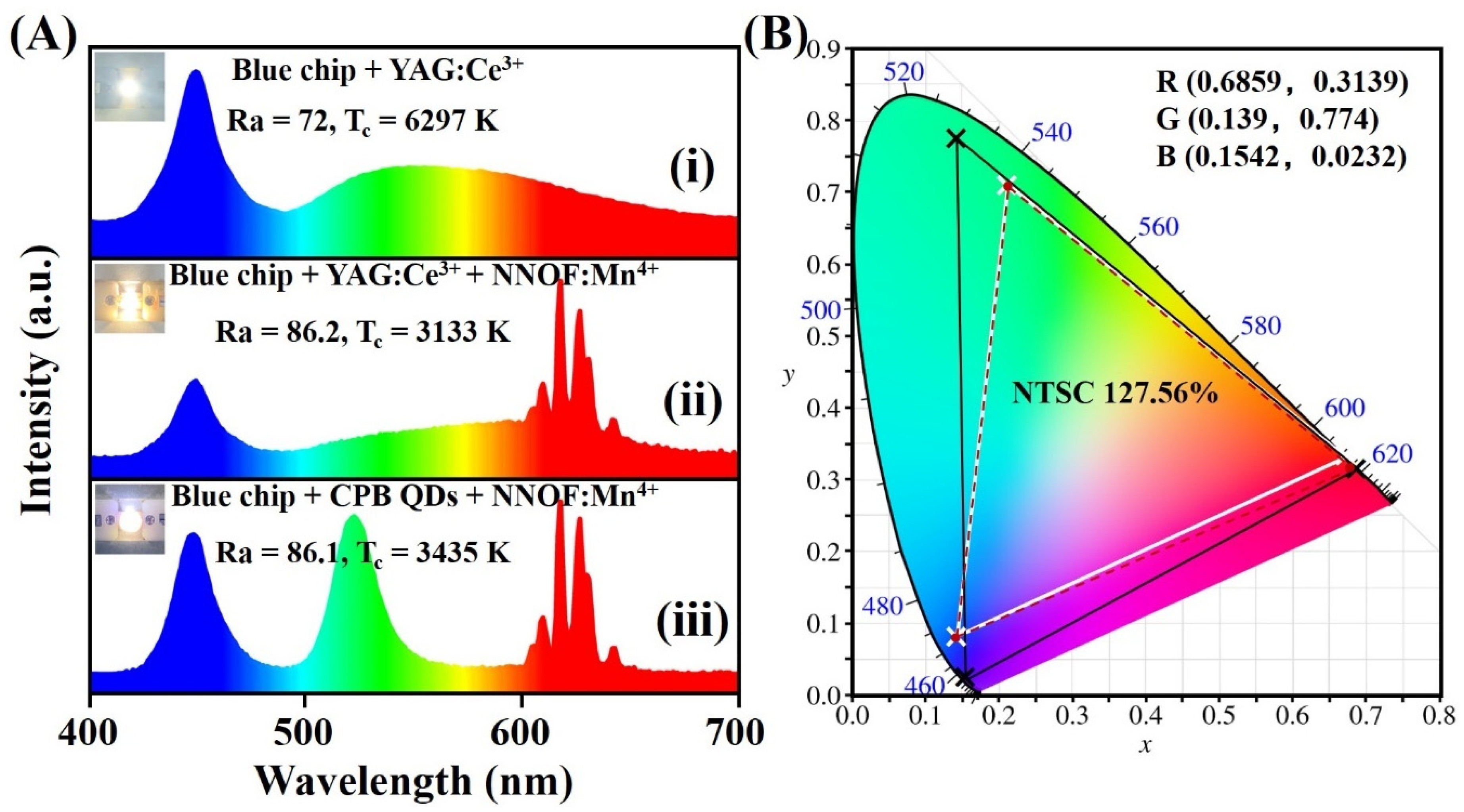
| Samples | The Molar Quantities of K2MnF6 (mol) | Actual Doping Amount of Mn4+ (x mol) |
|---|---|---|
| 1 | 3.2 × 10−6 | 0.001 |
| 2 | 6.4 × 10−6 | 0.002 |
| 3 | 9.6 × 10−6 | 0.003 |
| 4 | 1.6 × 10−5 | 0.005 |
| 5 | 3.2 × 10−5 | 0.01 |
| 6 | 6.4 × 10−5 | 0.02 |
| 7 | 9.6 × 10−5 | 0.03 |
| Compounds | σ2 | λ | ZPL Intensity |
|---|---|---|---|
| Na2NbOF5 | 43.6362 | 1.0184 | Very strong |
| K2SiF6 | 0.0000 | 1.0000 | Very weak |
Publisher’s Note: MDPI stays neutral with regard to jurisdictional claims in published maps and institutional affiliations. |
© 2021 by the authors. Licensee MDPI, Basel, Switzerland. This article is an open access article distributed under the terms and conditions of the Creative Commons Attribution (CC BY) license (https://creativecommons.org/licenses/by/4.0/).
Share and Cite
Hou, J.; Yin, W.; Dong, L.; Li, Y.; Liu, Y.; Liu, Z.; Zhao, G.; Zhang, G.; Fang, Y. A Novel Red-Emitting Na2NbOF5:Mn4+ Phosphor with Ultrahigh Color Purity for Warm White Lighting and Wide-Gamut Backlight Displays. Materials 2021, 14, 5317. https://doi.org/10.3390/ma14185317
Hou J, Yin W, Dong L, Li Y, Liu Y, Liu Z, Zhao G, Zhang G, Fang Y. A Novel Red-Emitting Na2NbOF5:Mn4+ Phosphor with Ultrahigh Color Purity for Warm White Lighting and Wide-Gamut Backlight Displays. Materials. 2021; 14(18):5317. https://doi.org/10.3390/ma14185317
Chicago/Turabian StyleHou, Jingshan, Wenxiang Yin, Langping Dong, Yang Li, Yufeng Liu, Zhifu Liu, Guoying Zhao, Ganghua Zhang, and Yongzheng Fang. 2021. "A Novel Red-Emitting Na2NbOF5:Mn4+ Phosphor with Ultrahigh Color Purity for Warm White Lighting and Wide-Gamut Backlight Displays" Materials 14, no. 18: 5317. https://doi.org/10.3390/ma14185317
APA StyleHou, J., Yin, W., Dong, L., Li, Y., Liu, Y., Liu, Z., Zhao, G., Zhang, G., & Fang, Y. (2021). A Novel Red-Emitting Na2NbOF5:Mn4+ Phosphor with Ultrahigh Color Purity for Warm White Lighting and Wide-Gamut Backlight Displays. Materials, 14(18), 5317. https://doi.org/10.3390/ma14185317








